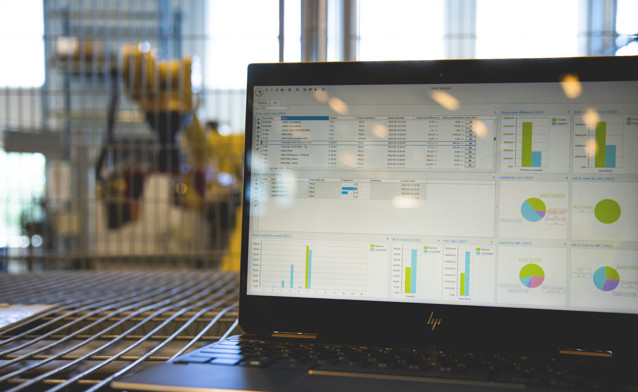Make the move from Excel to Monitor ERP
Save time and money by switching from spreadsheets to a single source of data
Using spreadsheets to track, manage, and maintain company data is a risky business, with studies suggesting over 80% of spreadsheets contain mistakes. Human error is a potential hazard for any computer program, but Excel is especially vulnerable. Once a set of spreadsheets is shared around a company it’s almost impossible to win back control.
With no single source of truth for your company’s data, you can’t be certain what changes have been made to your data once a spreadsheet is shared, nor if everyone is relying on the correct set of information.
So, what’s the solution? We look at six challenges manufacturers face when working with and managing data, transactions, operations, and users in their day-to-day work, comparing Excel spreadsheets with our enterprise resource planning system, Monitor ERP.
1. Keeping your data together
Excel
Excel is heavily reliant on manual input, increasing the risk of typographical errors and a classic spreadsheet pitfall: incorrectly configured formulas. A faulty formula left over time will see the mistakes pile up. Since Excel files are often saved on local drives, they’re also susceptible to accidental deletion, hardware failure or corruption.
Monitor ERP
Monitor ERP integrates a wide range of business processes (manufacturing, sales, purchase, stock management, sales, and accounting) into a single system, centralizing data, reducing silos, and ensuring everyone in the company has access to the same, up-to-date information. With real-time data updates, decision-makers can access accurate information to make timely, agile decisions, reacting to market conditions.

2. Internal collaboration
Excel
Sharing Excel files across employees, teams, and departments can cause a world of pain. And when more than one person is working on a spreadsheet, it’s easy to lose track of the latest version, or worse still, accidentally overwrite someone else’s work.
Monitor ERP
Monitor ERP enables different teams and departments to operate seamlessly, improving collaboration by giving employees access to shared data and resources. Orders, operations, transactions, and tasks can be tracked and managed across the company, helping to streamline workflows and prevent bottlenecks. In addition, user rights can be assigned according to individual company roles, ensuring the right people work with the right data.

3. Reporting and analytics
Excel
Excel comes with basic analytical functions, but it lacks the more sophisticated features of business intelligence tools that can drill down into detailed analytics and enable informed decision making.
Monitor ERP
Monitor BI (Monitor Business Intelligence) function converts company data into valuable business insights, helping managers to track and analyze data and trends, create compelling visualizations, and make smarter decisions. In today’s business climate, data-driven decision-making is increasingly important for manufacturers striving to gain a competitive edge.

4. Customer and supplier management
Excel
Excel simply wasn’t developed to contain, maintain, and track orders, or customer interactions – yet many still use it for this purpose. You may be able to manage with a small number, but as soon as your clientele grows, things can quickly get out of control. The same applies to the management of suppliers.
Monitor ERP
Monitor ERP includes CRM (customer relationship management) functionality to handle all contact with customers, so you can manage activities, customers, statistics, quotes, customer orders, and invoices linked to selected salespeople. It also facilitates supplier management, from comprehensive contact data to activities and suppliers’ status. This enables quicker order processing and better customer service.

5. Security, audit-trails, and data history
Excel
Excel is not equipped with a built-in audit-trail, so there’s no way to track who made changes and when they were made, nor can you easily revert to previous versions. This makes it harder to maintain accountability and identify errors. Many industries require audit-trials to comply with regulations, and Excel makes it difficult to meet these standards, exposing companies to legal risks.
Monitor ERP
Monitor ERP has robust security functions that allow businesses to manage which employees have access to specific types of information and areas of the system. This ensures data integrity and reduces the risk of breaches. In addition, frequent upgrades are made available to ensure you can always run the safest, latest version of the software.

6. Time and cost efficiency
Excel
Consolidating data from multiple spreadsheets is time-consuming and labor-intensive, negatively impacting a company’s bottom line. Reporting data is also more inefficient, as working in Excel requires manual formatting and preparation, which takes precious time – particularly if reports are needed frequently.
Monitor ERP
By streamlining processes such as production planning and order processing, and centralizing workflows under one system, Monitor ERP ensures resources are channeled where they’re needed most, saving time and costs for manufacturers. It also optimizes stock management, ensuring you always hold the right level of inventory and don’t unnecessarily tie up capital.

Thinking about getting an ERP system? Or switching to a new one? Help is at hand. Check out our webinar on demand!
On-demand webinar
In this free-of-charge webinar, we focus on the five key questions your company has to answer before changing to a new system.
- Why should I change ERP system?
- Will the system meet our needs?
- How does an installation or conversion work?
- How much does an ERP system cost to buy and implement?
- And most importantly, what will I gain from a new ERP system?

In summary
Excel is a powerful tool for organizing and visualizing data in spreadsheets. For smaller datasets, it works well as a simple database for the storage and retrieval of information.
However, when it comes to the day-to-day running of a manufacturing company dealing with larger volumes of data for customers, suppliers, stock, materials, and users, it simply doesn’t make the grade.
This is what Monitor ERP was designed to do. It simplifies and automates routine tasks like sales, order processing, stock management, invoicing and accounting, reducing the need for manual input and saving time. This improves collaboration, leading to better customer service, lower costs, and a stronger bottom line for manufacturers.






